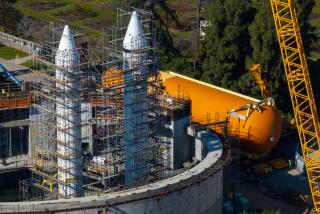NASA Is Still Puzzled by Discovery’s Foam Loss
- Share via
NASA officials said Tuesday that they still had not figured out what caused foam loss on this summer’s Discovery space shuttle flight, and are now facing a new problem of small cracks in the foam covering another external fuel tank.
However, officials said they had addressed two other safety problems that cropped up on the Discovery mission.
The cracks appeared after the tank was filled with supercooled rocket propellant this summer, officials said at a news conference at Johnson Space Center in Houston.
“We’re trying to come to grips with what that means,” said shuttle program manager N. Wayne Hale Jr.
Some NASA officials played down the possibility that the cracks in the tank’s insulation were related to the problem of falling foam. Foam debris striking the wing of the shuttle Columbia was the primary cause of the craft’s destruction on reentry in 2003. All seven astronauts died.
“We haven’t found any Eurekas or smoking guns,” said John Chapman, NASA’s external-tank manager.
Investigators are looking at new ways of applying the foam, as well as eliminating the foam from parts of the tank.
The external tank, which is adjacent to the orbiter, is filled with a propellant made of liquid hydrogen and liquid oxygen. Insulating foam is applied to the tank to keep ice from forming on it and breaking off and striking the orbiter.
NASA spent two years trying to fix the foam problem, only to see another large piece fall off Discovery’s tank this summer. The foam did not hit the orbiter, but NASA nonetheless grounded all future flights pending an investigation into the cause of the foam loss.
Investigators have focused on the possibility that the foam on Discovery’s fuel tank was damaged during application, shipping or repairs made at the Michoud, La., plant where the tanks are made.
The discovery of the cracks on a different tank has focused attention on the effects of the cooling and warming process on the super-thin metal skin of the tank and how those effects are transferred to the outside foam.
Officials think they have solved the problems with a frayed insulating blanket under the Discovery commander’s window and two protruding spacers between the craft’s heat tiles.
They have replaced 100 blankets on the shuttle and its sister ship, Atlantis, because of weak stitching.
The protruding gap fillers were blamed on poor adhesive, so engineers have begun a new testing process to make sure all gap fillers will be firmly seated before launch.
Program managers said it was possible they could still resolve the foam problem in time for a shuttle launch in May.
But they emphasized that they would not allow an arbitrary schedule to determine when the next mission will occur.
“We’re not driving to a calendar, to a date set arbitrarily,” Hale said.
More to Read
Sign up for Essential California
The most important California stories and recommendations in your inbox every morning.
You may occasionally receive promotional content from the Los Angeles Times.













